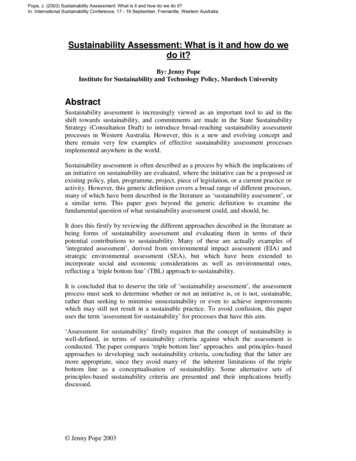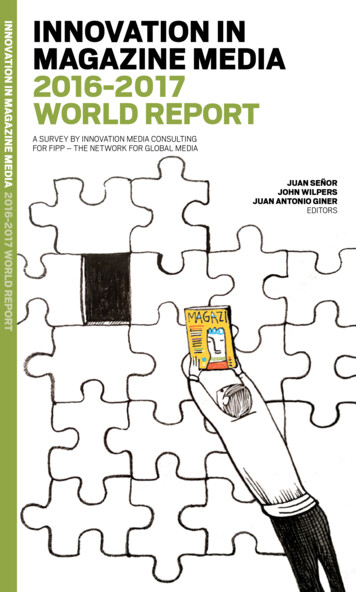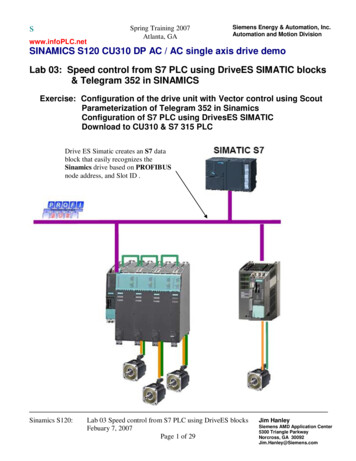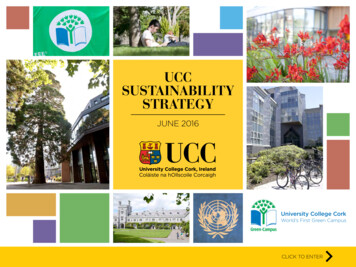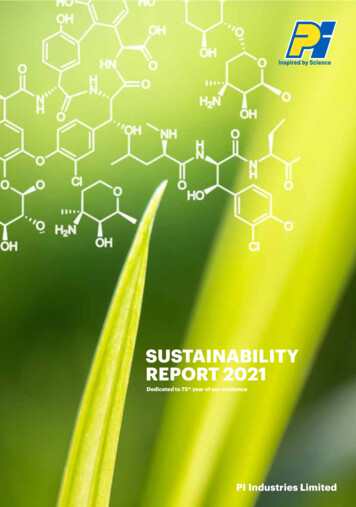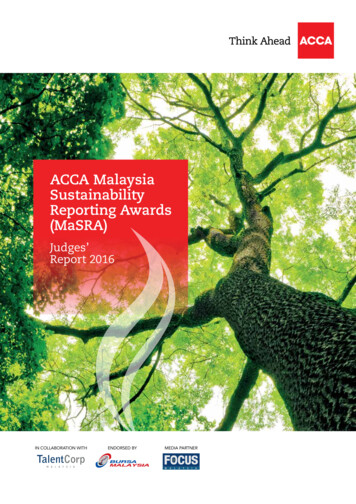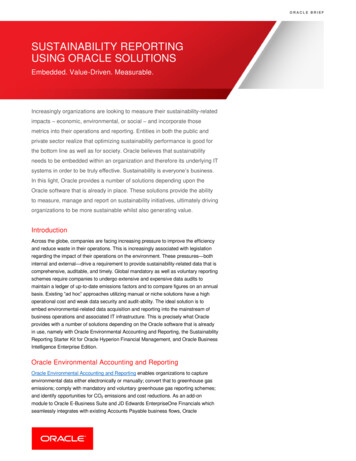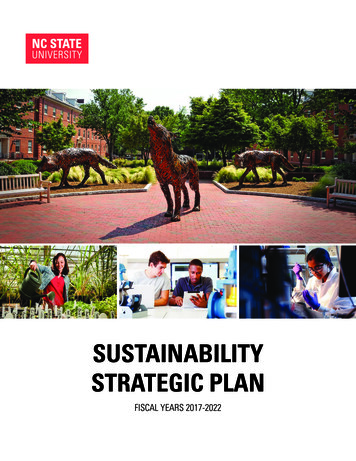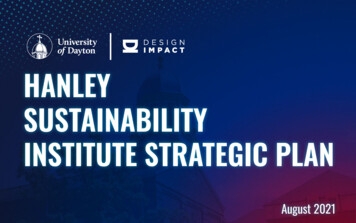
Transcription
HANLEYSUSTAINABILITYINSTITUTE STRATEGIC PLANAugust 2021
HSI’S STRATEGIC PLANHSI’s strategic plan was created to confront today’s urgentenvironmental challenges. It was co-created with the help,insights, and input of more than 250 diverse people to reflectthe perspectives of students, faculty and staff at the Universityof Dayton and local partners in the Greater Dayton region.This plan outlines four key commitments, or strategicpriority areas, to inspire and guide bold action for HSI duringthe next few years. It’s intentionally future-focused, settingbold goals that drive action. While HSI’s commitment to thiswork is not new (here’s a look at our impact report from2018-2020), this plan captures the renewed commitment andclarity for HSI’s future.HSI is committed to adjusting the plan along the way, creatingspace for emergence and continuously gathering (andresponding) to feedback.“Never has change been done and never will it be done withoutdifficulty.” - William Joseph Chaminade, Marianist founder2
TABLE OF CONTENTSINTRODUCTIONPRIORITY AREAS Overview . . . 5 Developing Leaders for a Just Future . . . 16 Strategic Planning Process . . . 7 Facilitating Impactful Research . . 21DELIVERABLES AND OUTPUTS Design Guidelines . . . 9 Catalyzing Institutional Transformation . . 25 Engaging Communities Beyond Campus . . 29 Defining Sustainability . . 10CLOSING HSI Vision and Mission . . . 11 Thank You . 363
INTRODUCTIONAmanda and George Hanley
OVERVIEW UD’s Hanley Sustainability Institute (HSI) wasfounded in 2014 with a major gift from George ’77and Amanda Hanley, to build on decades ofstudent, faculty and staff efforts in sustainability. Since its founding, the institute has taken stepstoward making the University of Dayton (UD) anational leader in sustainability. HSI’s work continues to be inspired by PopeFrancis’s call to integral ecology in On Care for OurCommon Home (Laudato Si) and connected withour Marianist Universities’ commitment to educatefor service, justice and peace, and integrity ofcreation. In 2019, HSI partnered with Design Impact (DI) toengage in a community-centered strategicvisioning process. While the Covid-19 pandemic created somechallenges, HSI and DI worked closely with faculty,staff, students, and other stakeholders to co-createa shared definition for sustainability, a clearmission and vision for the institute and thisstrategic plan. This document is intended to help guide HSI’s workfor the short and long term.5
BACKGROUND The Challenge of Our Time We live at a unique moment in human history: due to a convergence of climate, ecosystem, energy, water,resource, economic and equity crises, it has become clear that the status quo cannot be sustained verymuch longer. The dramatic expansion of the human footprint on Earth, which has been fundamentallyenabled by fossil fuels, will soon come to an end. Transformational change of some sort appears certain:the question is whether such change will be forced upon us by the biophysical realities of our finite planetor whether we will intentionally design fundamental changes to human systems in order to preserve oreven enhance human well-being while simultaneously enabling the regeneration of Earth’s systems. Our Legacy and Our Potential It is important to acknowledge that the land where HSI sits was for millennia the stewarded land of nativepeoples. By the 19th century, this land had become owned and cultivated agricultural land, in both Westernsenses of private property and increasingly profit-based agriculture. In the mid-20th century, the buildingthat is now called Fitz Hall was newly constructed as a prominent part of Dayton’s industrial landscape. HSI,founded in 2014, is an outgrowth of decades of sustainability efforts at UD, as recently chronicled in apodcast. HSI’s efforts have already had a strong influence on UD (recent work highlighted here). With thisstrategic plan, we look forward to the next several years and the transformative impacts that are possible insustainability education, research, operations, and community engagement.6
STRATEGIC PLANNING PROCESS1. DISCOVERY - The team engaged nearly 200 people in discovery tohelp identify key opportunities for HSI to pursue action.2. SYNTHESIS - Based on the outputs from the discovery engagements,the core team identified key priority areas (or opportunities) for thestrategic plan.3. IDEATION - The key themes became the catalyst for shaping ideas forHSI to prioritize in its strategic plan. Once again, a broad group ofstakeholders was engaged to help brainstorm and share ideas.4. DRAFT & FEEDBACK - The ideation results were compiled into an initialdraft and feedback was solicited from a broad group of stakeholders inApril 2021.5. COMPLETE VERSION & IMPLEMENTATION - In the summer of 2021,HSI developed this version of the strategic plan and will spend the fallof 2021 developing implementation plans.Read the Synthesis Report Here7
DELIVERABLES& OUTPUTS
GUIDING PRINCIPLESThese guidelines surfaced as key principles to shape all aspects of the strategic plan. No matter the focus area, these guidelines must beconsidered for HSI to succeed. Less Is More: Don’t do too much;focus on a few things and dothem well. Make It Relevant: Help people seethe connection between their day today behaviors, choices and actions tothe future state of the world. Connect To Catholic And MarianistValues and Insights: Engage andadvance the work of Laudato Si, ascare for the common good and ourcommon home are not just technicalbut also social and spiritualchallenges. Make It Actionable: Ensure thestrategic plan is action-oriented andbig goals are backed with practical,immediate action steps. Be Consistent: All of HSI’s policiesand practices should embody a clearcommitment to sustainability evenwhen it’s inconvenient. Weave It In: Staff and facultymembers’ time is limited, find ways toincorporate their involvement intothings they are already doing or forwhich they are responsible. Elevate Equity: In order for thisplan to be successful, HSI mustcenter diversity, equity and inclusionin the intent and execution of thestrategic plan. Be Transparent: Bring others alongand invite people to see what you’redoing, how you’re doing it and whyyou’re doing it. Take Risks: Strive for lasting andimpactful change, not marginalimprovements.9
DEFININGSUSTAINABILITYWe understand a number of differentdefinitions exist for sustainability. HSIgathered input from more than 100people to shape the definition ofsustainability that the institute will useto guide their work with UD, theDayton community and beyond.This definition models how HSIunderstands sustainability:Sustainability entailsan enduring shared responsibilityto care for our common home bypreserving the vitality of Earth’sfragile ecosystems whileadvancing human rights andsocial justice, both now and forevery generation.
HSI VISION AND MISSIONVision - Our vision statement attempts to capture what HSI aims or aspires to do through its work.Cultivating a just transition to a sustainable future that protectsand preserves humanity and the planet.Mission - Our mission statement attempts to capture HSI’s objectives and activities.HSI's mission is to be a dynamic learning community that advances sustainability by educatingand mentoring transformational leaders, facilitating impactful and transdisciplinary research,catalyzing sustainable practices within our institution, and building caring relationships withcommunities beyond campus.11
UD’SSUSTAINABILITYLANDSCAPEHSI exists within a larger ecosystem atUD and the broader community.There are a variety of initiatives,councils, organizations, academicunits, student clubs, facilities andadministrative teams and othersworking to elevate sustainability at UD.In order to be successful and have thegreatest impact, HSI must collaboratewith and complement existingsustainability efforts, both within thecampus and broader communities.
STRATEGICPRIORITY AREAS“Strategies for a solution demand an integrated approach tocombating poverty, restoring dignity to the excluded, and at thesame time protecting nature.” - Pope Francis, Laudato Si #139
STRATEGIC PRIORITY AREASBased on the discovery process, four key priority areas emerged for HSI to focus their time, energy and resources:DEVELOPINGLEADERS FOR AJUST TUTIONALTRANSFORMATIONInspire, prepare andequip students toleave campusaware of their roleand confident in thetools they have tobe transformativeleaders for a better,more just, andsustainable future.Catalyze andsupporttransdisciplinary andcommunity-basedresearch thataddresses rootcauses and drivesaction onsustainabilitychallenges, globallyand locally.The University canmodel and create amore sustainablefuture bytransforming itspolicies andpractices with theengagement ofleadership, staff,faculty, andstudents.ENGAGINGCOMMUNITIESBEYOND CAMPUSAdvancesustainability,resilience andintegral ecologybeyond UD bycreating deep andmutually beneficialrelationships withcommunitypartners.14
GOALS AT A GLANCEDEVELOPINGLEADERS FOR AJUST TUTIONALTRANSFORMATIONENGAGINGCOMMUNITIESBEYOND CAMPUSGOAL 1: Strengthenand ExpandSustainabilityEducation to theEntire Student BodyGOAL 1: CatalyzeMeaningfulResearchPartnershipsGOAL 1:Co-FacilitateCampusSustainabilityPlanning andCoordinationGOAL 1: SupportSustainability Planningand Tracking BeyondUDGOAL 2: FosterStudent Leadershipand AdvocacyGOAL 3: IntegrateSustainability intothe UD Student LifeExperienceGOAL 2: Supportand PromoteSustainabilityResearchGOAL 2: Inspire andEnableSustainability EffortsAcross CampusGOAL 2: Become aResource and Hub forSustainabilityEducation Beyond UDGOAL 3: FacilitateCampus-CommunityClimate ResilienceEfforts15
DEVELOPINGLEADERS FORA JUST FUTURE
DEVELOPING LEADERSFOR A JUST FUTURESUMMARY - Inspire and equip students to leave campus aware oftheir role and confident in the tools they have to shape a better, morejust, and sustainable future. Prepare students to think critically andcreatively about humanity and the common good.WHAT WE ASKED OURSELVES How might HSI equip students to organize, advocate, and impactpolicy, practices and daily decisions around sustainability?PERSPECTIVESFROM DISCOVERY Students distrust leadershipand organizations/governments because theyhaven’t seen their voices andconcerns represented orwitnessed their input lead toany action. UD students can think outsidethe box and help design anddevelop projects that cantransform the community. How might HSI partner with other departments and initiatives oncampus to embed sustainability education into existing academiccourses, curriculum and other educational opportunities that mayotherwise seem disconnected? How might HSI center and model the Catholic, Marianist values ofcaring for the common good in the student experience and in theirunderstanding of sustainability?17
GOAL 1: STRENGTHEN AND EXPAND SUSTAINABILITYEDUCATION TO THE ENTIRE STUDENT BODYDESCRIPTION Strengthen educational programs for students already focusing onsustainability, promote collaborations with students in programsfocused on justice and social change, and ensure that every UDgraduate has a solid understanding of the sustainability challengesthat will shape their future.Specific ideas include: Curating sustainability-focused internship andresearch opportunities; weaving sustainability into first year courses;integrating sustainability into capstone and senior design courses;providing mini-grants to faculty to incentivize inclusion ofsustainability into their courses; integrating it in co-curricular learningexperiences; and developing one or more sustainability presentations(by HSI faculty, staff, or students) that could be included in all firstyear fall intro courses (potentially New Student Orientation).IMPACT Every student leaves UD with relevant knowledge and skillsto live more sustainably and shape a more just future.DEVELOPING LEADERS FOR A JUST FUTUREROLES AND RESOURCES NEEDEDHSI’s Role: Weave sustainability intocurriculum, whether that’s expandingexisting experiential learningprograms, creating new programs orscaling current ones. Make it easier,and also facilitate incentives, forinstructors to engage sustainabilitymaterial.Potential Partners Could Include:Learning Teaching Center, StudentDevelopment, Common AcademicProgram (CAP), Center for OnlineLearning, Coordinators of capstonecourses, Fitz Center for Leadership inCommunity, Human Rights Center,Center for Social Concern, Marketing& Communications, Office ofExperiential LearningPotential Resources Could Include:Incentives and resources for facultyto help weave sustainability intoexisting course curriculum.
GOAL 2: FOSTER STUDENT LEADERSHIP AND ADVOCACYDESCRIPTION Cultivate experiential learning opportunities for students tobecome effective sustainability advocates and change agents inthe community. Lean into our Catholic, Marianist values, insightsand connections to shape and promote leadership and advocacythat honors all living creatures.Specific ideas include: Ensuring students have opportunities topursue training to develop their leadership and advocacy skills;mentoring students engaged in sustainability advocacy; embeddingstudents into decision-making and operational aspects of universitysustainability, where students can help ensure accountability whilegaining valuable leadership skills and experience.IMPACT Creates opportunities for students to apply classroomknowledge to real problems on and off campus; thisexperiential learning benefits students beyond graduation. Strengthens the connections between students andcommunity partners in the Greater Dayton region.DEVELOPING LEADERS FOR A JUST FUTUREROLES AND RESOURCES NEEDEDHSI’s Role: HSI can connect studentswith experiential learning andtraining opportunities to help thembecome sustainability advocates.Potential Partners Could Include:Fitz Center for Leadership inCommunity, Learning TeachingCenter, Center for StudentInvolvement, Housing andResidence Life, Facilities andadministrative offices, StudentGovernment Association, HumanRights Center, local/regionalgovernmental leaders, faculty (toteach students about policy makingand advocacy), Office of ExperientialLearning, Honors Program, CampusMinistry, Dicastery for the Promotionof Integral Human DevelopmentPotential Resources Could Include:Coordination, online inventory ofopportunities for students
GOAL 3: INTEGRATE SUSTAINABILITYINTO THE UD STUDENT LIFE EXPERIENCEDESCRIPTION Partner with Facilities, Housing and Residential Life, CampusMinistry/Center for Social Concern and other stakeholders tointegrate sustainable practices into the UD student experience.Specific ideas include: more advanced recycling, composting,accountability/incentives and understanding of energy usage andutility bills, community gardens in the student neighborhood, astudent-run non-profit thrift/reuse store, and integrating ecologicalspirituality into retreats, service and other faith experiences. Provide more formal support and mentorship to studentorganizations with environmental and interconnected themes insocial justice and human rights.IMPACT By integrating sustainability into student life, students developlife-long habits and truly integrate sustainable principles intotheir life rather than seeing it as something separate.DEVELOPING LEADERS FOR A JUST FUTUREROLES AND RESOURCES NEEDEDHSI’s Role: As advisors and experts,HSI collaborates with campusgroups to advise on the bestpractices to integrate sustainabilityinto the UD student experience.Potential Partners Could Include:Housing and Residence Life, DiningServices, Facilities Management,Student Government Association,Office of Mission and Rector,Campus Ministry and Center forSocial Concern, Honors Program(Chaminade Scholars), Crotty Centerfor Entrepreneurial Leadership,Flyer EnterprisesPotential Resources CouldInclude: Physical space to convenepeople; financial investments
FACILITATINGIMPACTFULRESEARCH
FACILITATING IMPACTFULRESEARCHSUMMARY - Catalyze and support transdisciplinary andcommunity-based research and scholarship that addresses rootcauses and drives action on sustainability challenges, globally andlocally. We will continue to prioritize our support for research that hasthe potential to advance transformative change in addressingsustainability challenges. One of HSI’s core goals is to support thetranslation of sustainability research outputs into more accessibleformats for non-academic communities.PERSPECTIVESFROM DISCOVERY Collaborate with communitypartners to co-createsustainable solutions bysharing and translatingresearch and best practices. HSI has access to insights andsolutions through theirconnection to scholars acrossthe disciplines. It’s important toleverage this as part of theiridentity and how they supportcommunity partners.WHAT WE ASKED OURSELVES How might HSI facilitate sustainability research, especiallytransdisciplinary research that is action-oriented, responsive tocommunity needs, and able to drive change both in the GreaterDayton region and around the world?22
GOAL 1: CATALYZE MEANINGFUL RESEARCH PARTNERSHIPSDESCRIPTION Foster and facilitate collaborations among UD faculty andresearchers, as well as between UD and community partners (in theprivate and public sectors), by stimulating conversations andbuilding mutually-beneficial relationships. This includes HSI’s desireto catalyze relationships with external funders of research. Host summits and roundtable discussions on sustainability issueswith local and state environmental organizations, businesses,industry leaders, policymakers, and community leaders. Translateresearch outputs to be more accessible to policymakers and thegeneral public to increase the impact of the research. Provide training and mentorship to UD scholars who are interestedin, but newcomers to, community-based participatory research.IMPACT Expands UD’s capacity for cross-disciplinary and externallyfunded sustainability research. Makes research at UD accessible to non-academic partnersand creates relationships to advance the common good.FACILITATING IMPACTFUL RESEARCHROLES AND RESOURCES NEEDEDHSI’s Role: Develop and publicizephysical and virtual fora for buildingresearch partnerships, develop ways ofdocumenting productive partnershipsthat don’t necessarily or immediatelyproduce scholarly research outputs,develop and expand connections withfunding agencies, foundations, andpartners in the public and privatesectors.Potential Partners Could Include:Sustainability Scholars across campus,non-profits, local communityorganizations, funding agencies, privatefoundations, local businesses andindustries.Potential Resources Could Include:Funding (materials, travel support),templates for collaboration agreementsto support new interdisciplinary andtransdisciplinary partnerships with ashared understanding of expectationsand responsibilities.
GOAL 2: SUPPORT AND PROMOTE SUSTAINABILITY RESEARCHDESCRIPTIONROLES AND RESOURCES NEEDED Build capacity for sustainability research at UD by providing directfinancial and/or institutional support.HSI’s Role: Secure and allocatefinancial and institutional supportfor sustainability research in theareas of emphasis through a varietyof mechanisms. Provide support toscholars looking to expand theirresearch portfolios in these areas. Give special emphasis to research that (1) deeply engages thecommunity to advance sustainability, (2) brings different disciplinestogether to tackle challenges in new ways, and (3) develops newframeworks for understanding or framing sustainability challenges.Specific ideas include: seed grants, compensation for communityparticipants in research, supporting citizen science, course releasesfor faculty, support for proposal-writing, research fellow positions,support for open-access publication fees, funding undergraduateresearchers, recruiting graduate students, and developing aninterdisciplinary graduate program in sustainability.IMPACT Promotes and supports transdisciplinary, collaborative,transformational, and community-centered research. Reimagines and expands UD’s framework for institutionalsupport of research and leverages existing infrastructure.FACILITATING IMPACTFUL RESEARCHPotential Partners Could Include:Sustainability Scholars acrosscampus, UDRI, academic units, UDextramural funding support staff,UD Advancement.Potential Resources CouldInclude: Stipends and support forparticipants in community-basedresearch; seed grants;undergraduate and graduatestudent opportunities.
CATALYZINGINSTITUTIONALTRANSFORMATIONMODELING A SUSTAINABLE FUTURE
CATALYZING INSTITUTIONALTRANSFORMATION: MODELINGA SUSTAINABLE FUTURESUMMARY - The University can model and create a more sustainablefuture by transforming its policies and practices with the engagementof leadership, staff, faculty and students.WHAT WE ASKED OURSELVES How might HSI work with campus leaders, staff, faculty, andstudents to influence sustainability decisions and encourage boldaction to improve the sustainability of our campus?PERSPECTIVESFROM DISCOVERY HSI could help integrate thingsthat are already happeningaround sustainability. Rightnow initiatives are connectedto certain groups versus acampus wide culture andmovement towardssustainability. “HSI needs to break barriers(between departments,individuals, etc), connect thedots, look at whole systems.”—sustainability philanthropist How might HSI instill positive sustainability mindsets and practicesamong students, faculty, and staff so that it becomes a seamlesspart of the culture, impacting students beyond their time at UD? How might HSI connect and inform siloed programs and initiativesrelated to sustainability so that the efforts can be comprehensiveand higher impact?26
GOAL 1: CO-FACILITATE CAMPUS SUSTAINABILITYPLANNING AND COORDINATIONDESCRIPTION Co-facilitate the work of a standing team of UD faculty, staff andstudents that co-creates a campus sustainability and climateaction plan, ensures alignment across campus units inimplementing that plan and periodically assesses and refines theplan in coordination with senior leadership and the CARES Council. Encourage the campus to lean into best practices emerging fromthe COVID-19 pandemic that also have a positive sustainabilityimpact, such as migration to electronic forms and appropriatealternatives to travel and commuting.IMPACT A comprehensive sustainability and climate action plan isimportant to ensure UD meets its Climate LeadershipCommitment, that UD meaningfully engages the Laudato SiAction Platform, that campus leaders continue to prioritizesustainability, and that more sustainable processes develop asdepartments settle into a post-pandemic new normal.CATALYZING INSTITUTIONAL TRANSFORMATION: MODELING A SUSTAINABLE FUTUREROLES AND RESOURCES NEEDEDHSI’s Role: Engage a pool of faculty,staff, and students across campus toparticipate in sustainability planningand coordination processes.Contribute HSI staff time toco-facilitate these campus-levelefforts in concert with other keystakeholders.Potential Partners Could Include:Senior leadership, CARES Council,Facilities Management, Housing andResidence Life, other offices acrosscampus, faculty in all academicunits, students from all majors.Potential Resources Could Include:Staff time will need to be allocatedto collaborate with staff in other unitsto provide ongoing support for theplanning and coordinationprocesses, and to ensure robustengagement of the campuscommunity.
GOAL 2: INSPIRE AND ENABLESUSTAINABILITY EFFORTS ACROSS CAMPUSROLES AND RESOURCES NEEDED Provide individual consulting and/or advising for departments orunits across campus that seek to internalize and activate thecampus-level sustainability plan or develop their own plans.HSI’s Role: Develop programs fordepartment-level sustainabilityassessment/planning, for engagingthe campus community in suchefforts, and for supportingsustainability reporting activities. Inspire and engage the campus community (students, staff, andfaculty) to advance the campus sustainability plan.Potential Partners Could Include:Literally everyone on campus. Support and help expand campus sustainability reporting,including for Second Nature, the Laudato Si Action Platform, andAASHE’s STARS.Potential Resources Could Include:Student and/or staff time to developan assessment process and toconsult with individualdepartments/units (building on HSI’sOffice Ecology pilot program); webdevelopment support to develop anonline space for recognizing bothindividual and departmental efforts;student, staff and/or faculty time tosupport sustainability reportingefforts.DESCRIPTIONIMPACT UD can only become a truly sustainable university if the entirecampus is inspired to participate and empowered with theknowledge to make their sustainability efforts successful. Supporting Facilities Management in their sustainabilityreporting work will help inform campus efforts and assist theUD in achieving greater recognition (e.g., STARS Platinum).CATALYZING INSTITUTIONAL TRANSFORMATION: MODELING A SUSTAINABLE FUTURE
ENGAGINGCOMMUNITIESBEYOND CAMPUSENSURING OUR IMPACT EXTENDS EXTERNALLYNote: Relevant communities exist at many scales beyond the UDcampus. This broad range of stakeholders may include the GreaterDayton community, UD’s alumni network, local/regionalbusinesses and non-profit organizations, the broader Marianist andCatholic communities and ultimately the world at large. Theappropriate scale for our engagement will vary for each goal andwill vary over time as HSI’s impact grows from local to international.
ENGAGING COMMUNITIES BEYONDCAMPUS: ENSURING OUR IMPACTEXTENDS EXTERNALLYSUMMARY - Advance sustainability, resilience and integral ecologybeyond the UD campus by creating deep and mutually beneficialrelationships with community partners, while hewing to ourinstitutional commitment to the Community-Based Global LearningCollaborative.WHAT WE ASKED OURSELVES How might HSI build relationships with community partners thatlead to reciprocal and productive partnerships? How might HSI have a positive impact on sustainability challengesat local, regional, national, and international scales?PERSPECTIVESFROM DISCOVERY “UD/HSI has the ability to scaleup solutions. Their partnershipswithin their communities canbe leveraged to go ‘intogether’ on renewable energysolutions to make actions moreeconomically viable.”—recent UD alum HSI can work well asconveners, especially if therecould be more convening onrelated topics happening offcampus. Tear down thosepsychological barriers to bringpeople to the campus.30
GOAL 1: SUPPORT SUSTAINABILITY PLANNINGAND TRACKING BEYOND UDDESCRIPTION Serve as a resource for local cities, counties and other entitieswhich are undertaking sustainability planning efforts. Work with local community partners to improve sustainabilitytracking platforms (including Bring Your Green), expandparticipation and provide support to participants across the GreaterDayton community. Contribute expertise to the development andimplementation of the Laudato Si Action Platform. Train a cohort of students to assist with greenhouse gas emissionsinventories and connect them with community partners.IMPACT Leverages sustainability expertise and student enthusiasmat UD to facilitate progress on sustainability planning andtracking in the broader community. Builds deep, meaningful relationships with communitypartners in a systematic way.ENGAGING COMMUNITIES BEYOND CAMPUS: ENSURING OUR IMPACT EXTENDS EXTERNALLYROLES AND RESOURCES NEEDEDHSI’s Role: Engage students, staff,and faculty to work with communitypartners on sustainability planningand tracking efforts.Potential Partners Could Include:Dayton Regional Green (developersof Bring Your Green platform), localcounty and city governments, BringYour Green participants, Dicastery forPromoting Integral HumanDevelopment (Laudato Si ActionPlatform), UD students, staff andfacultyPotential Resources Could Include:Staff and/or student time, seedfunding for community sustainabilityefforts
GOAL 2: BECOME A RESOURCE AND HUBFOR SUSTAINABILITY EDUCATION BEYOND UDDESCRIPTION Plan, facilitate or curate community-based workshops onsustainability topics identified by community partners. For example,HSI could bring together Dayton food service businesses to learnabout (and track) sustainability metrics. Advance the design and development of more just and sustainableeconomies through workshops, roundtable discussions,certifications, minors, or other structured curricular tracks,incorporating community leaders as teachers and presenters. Develop programs and resources that integrate our Catholic,Marianist identity and engage faith-based communities to advancethe understanding and practice of integral ecology.IMPACT Expands HSI’s educational impact beyond UD, bridgingcampus and external communities to foster a betterunderstanding of sustainability challenges and responses,ultimately leading to action at larger scales.ENGAGING COMMUNITIES BEYOND CAMPUS: ENSURING OUR IMPACT EXTENDS EXTERNALLYROLES AND RESOURCES NEEDEDHSI’s Role: Convene and connectsustainability leaders, communitypartners and other stakeholders; planand promote workshop series;develop programs and resourcestargeting faith-based communities.Potential Partners Could Include:Dayton Regional Green and HeapyEngineering (PIVOT), Co-Op Dayton,Center for Leadership, UD faculty insustainability and economics,businesses and community leaders,Association of Marianist Universities,Mission of Mary Cooperative,Marianist Lay Communities of NorthAmerica, Marianist EnvironmentalEducation Center,
While HSI's commitment to this work is not new (here's a look at our impact report from 2018-2020), this plan captures the renewed commitment and clarity for HSI's future. HSI is committed to adjusting the plan along the way, creating space for emergence and continuously gathering (and responding) to feedback. 2 HSI'S STRATEGIC PLAN
